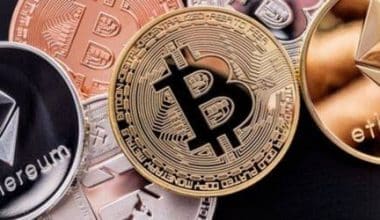“What is a Bitcoin, and how does Bitcoin work?” are two prominent questions that everyone since 2017 has asked at least once.
Bitcoin is comprised of two words: ‘Bit’ and ‘Coin.’ Basically you’d find 1s and 0s if you divide the information inside computers into smaller parts. These are referred to as bits. You are already familiar with coins.
…but what exactly are Bitcoins?
Bitcoins are simply the plural form of Bitcoin. They are coins that are saved on computers. They do not exist in the physical world and only live in the digital realm! That is why Bitcoin and other cryptocurrencies are frequently referred to as digital currency.
It can be quite confusing at first, but I’ll try to make it as simple as possible in this guide. Even complete beginners will grasp what Bitcoin is, how to obtain Bitcoin, and how to utilize Bitcoin by the end of this post.
If you intend to buy or sell Bitcoin, you should also look into some reputable cryptocurrency exchanges like eToro, Coinbase or binance. Furthermore, it is critical to keep your Bitcoins in safe wallets, so think about hardware choices like the Ledger Nano S and Trezor.
You should also be aware that the simplest way to buy Bitcoins with a credit card is through Simplex – a fraud-free payment processing service. You have an option.
Let’s get started!
What Is the Process of Bitcoin? What Motivated the Development of Bitcoin?
Let us begin with the fundamentals…
In the world at large, there are three categories of people: producers, consumers, and middlemen. If you want to sell a book on Amazon, you must pay a significant 40-50 percent commission. This is true in nearly every industry! The middlemen always take a large portion of the money from the producer.
To understand what Bitcoin is, you must first understand why it was created. Bitcoin was created to eliminate one form of middlemen—banks. If you need to send $5,000 from your country to a friend in the United Kingdom, you must do so through a bank in your own country. They charge a processing fee. When the money arrives at the bank in the UK, your friend’s bank charges a fee as well.
So basically, Bitcoin sort of, eliminates the regulations and processes with banks.
Why it was Created?
The issue isn’t simply the costs; it’s also the data they store. Banks save a lot of personal information on their customers. Many banks have been hacked in the last fifteen years, posing a serious risk to individuals who often use them. This is why it is crucial to understand how Bitcoin works.
Banks, unlike this crypto, have the ability to freeze/block people’s accounts at any time. They have far too much influence over the people who use banks, and they have exploited it. Banks also had a significant influence in the 2008 financial crisis. Bitcoin began in 2009, shortly after the financial crisis. Tons of crypto experts feel that the financial crisis was one of the driving forces for the creation of Bitcoin.
The solution was to create a system with no single point of authority (like a bank). People should not be controlled by a single authority. And because the currencies were controlled by banks and governments, a new currency had to be created.
Bitcoin is the solution because it is decentralized. That means no banks, PayPal, or the ability for the government to instruct the bank to freeze your account. Isn’t it fantastic? The question on everyone’s mind right now has to be, “How does bitcoin work?” ’.
How Does Bitcoin Work?
The developer of Bitcoin devised three key concepts for Bitcoin that are critical to understanding the fundamentals of Bitcoin:
- Cryptography
- Demand and Supply
- Networks that are not centralized
Let’s take a deeper look at each concept.
#1. Networks that are not centralized
When you enter the URL ‘www.google.com‘ into your internet browser, your computer initiates communication with Google’s servers. Then, your computer and their servers commence communications with each other, and your browser displays graphics, buttons, and so on. You wouldn’t be able to see these graphics and buttons if Google’s servers were down for any reason. This is due to the fact that the data is stored on a centralized network – it is all in one place. For decentralized networks, it is a different story.
Basically, for deentralized networks, data is dispersed.
You would still be able to see the data if Google adopted a decentralized network since it is everywhere, not just in one place. This implies that Google will never go offline!
#2. Cryptography
Cryptography was widely employed during World War II. It transformed radio signals into code that no one could understand. To read it, you’d have to go back to the original message. You needed a key to do so. It was made feasible through mathematical formulas!
Cryptography is used in the same way by Bitcoin. But instead of converting radio transmissions, Bitcoin converts transaction data using cryptography. This is why Bitcoin is categorized as a cryptocurrency. And knowing this brings you one step closer to comprehending how Bitcoin works.
The blockchain is what helps Bitcoin achieve this. The blockchain technology was invented by the founder of Bitcoin!
#3. Demand and Supply
When Petterson went to the bakery last week, there was only one cake left. Four other individuals were interested in it as well. Normally, the cake costs only $2. But because there were four other individuals who wanted the cake, he had to pay $10 for it.
This is the fundamental principle of supply and demand. When something is scarce, it has greater value. The more people who desire it, the higher the price will rise. It’s the same as collecting rare vintage autos.
This is the same approach that Bitcoin employs. Bitcoin’s supply is limited. Bitcoin is produced at a set rate that will drop over time – it will be cut in half every four years. Bitcoin has a 21 million coin limit; once there are 21 million Bitcoins, no further coins may be minted. How many Bitcoins are there right now? As of today, there are 18.5 million Bitcoins in circulation. We still have a long way to go until we reach 21 million!
So that answers a portion of the question, “How does Bitcoin work?” ”, but it does not address all of them. To truly understand how Bitcoin works, we should look at how Bitcoin transactions function…
How Do Transactions Take Place?
Let us now examine how these ideas interact with one another.
In a centralized network, this would generally be held in a single location. The Bitcoin database, on the other hand, is shared because Bitcoin operates on a decentralized network. The blockchain is used to access this shared database, which is known as a distributed ledger. Read my “Blockchain Simplified” guide to learn more about blockchain technology and better understand what Bitcoins are from a blockchain perspective.
Basically, to send Bitcoin to another person, you must digitally sign a message that says, “I am sending 50 Bitcoins to Brandy.” The message would then be sent to all computers on the network.
Can Someone Fake My Identity?
When you set up a Bitcoin wallet (to store your Bitcoin), you receive a public key and a private key. Public keys and private keys are a series of long numbers and letters; they are like your login and password. Both are highly necessary for properly understanding how Bitcoin works.
People will require your public key if they want to send you money. Nobody needs to know your name or email address because it is just a series of numbers and digits. This effectively anonymizes Bitcoin users!
Blockchain Wallet Private key: How does it work?
You should never allow anyone view your private key. Your private key is your identity on the blockchain. To gain access to your Bitcoin, you must use your private key. In other words, if someone sees it, they have the ability to steal all of your Bitcoin – so be very cautious!
So, in theory, your identity can be forged. If someone obtains your private key, they will be able to transfer Bitcoin from your wallet to their wallet. This is why you must keep your private key in a secure location.
However, your true identity (name, address, etc.) cannot be forged because you do not need it to send or receive Bitcoin.
Is it Possible to Spend Bitcoin twice?
Transactions are aggregated and saved in blocks. In a series, these blocks are linked back to one another. This is why it is referred to as a blockchain.
A public key is written on each transaction in the block. If it’s your Bitcoin, it’ll have your private key inscribed on it. And because each block is linked to the one before it, no Bitcoin may be spent more than once.
Real-World Example
Let’s look at some real-world examples to see how Bitcoin works. This is what would happen if someone tried to send the same Bitcoin twice:
Josh sends Thamyris a Bitcoin payment;
The transaction is recorded in a blockchain block.
The following day, Josh attempts to send the same Bitcoin to someone else.
The Bitcoin transaction is recorded in the blockchain’s current block.
The computers that operate the blockchain examines the most recent block where Bitcoin was utilized;
The transaction in the last block states that the Bitcoin was transmitted to Thamyris’ public key.
So because the Bitcoin being transmitted into the current block does not contain Josh’s public key, the computers operating the blockchain do not allow it to be utilized.
What if someone tampers with the blocks?
If someone tries to edit the transaction data in one of the blocks, it will only affect their own version, similar to a Microsoft Word document saved on your computer.
This is one of the most important aspects of how Bitcoin works. To get the modification onto the shared database and onto everyone’s version, they will need to control 51% of the computers on the network.
What if someone has 51 percent of the network’s computers under their control?
Technically, this is possible, but it is nearly impossible to achieve. Even if someone compromised 51% of the computers in the network (also known as nodes), there is another degree of security that prevents them from gaining access.
New blocks must be mined in order to be added to the network. This process is known as mining because the nodes that participate in it are rewarded with Bitcoin, same to how gold miners are rewarded with gold.
Mining requires nodes to process Bitcoin transactions and verify that they are genuine. They must solve a mathematical problem in order to do so. When the issue is resolved, the block of transactions is confirmed and a new block is formed. Each block introduces a new problem and a new solution for miners to discover.
The first node to solve this puzzle is rewarded with fresh Bitcoins. Basically, mining consumes a lot of electricity, so the miners must be compensated!
Here are some additional real-world examples of how Bitcoin works:
Consider what would happen if a hacker controlled 51 percent of the nodes and attempted to modify a block:
The hacker will modify the contents in the block such that the Bitcoin is sent to his or her public key.
And because the data in the block has changed, a new mathematical problem has arisen, which the hacker must solve.
The electricity required by the hacker to solve the problem is more expensive than the Bitcoin in the block.
The hacker can continue and fix the problem, but he will lose money.
As you can see, it is nearly impossible for a hacker to accomplish a blockchain attack. That is why it is so safe.
What are the Benefits and Drawbacks of Bitcoin?
After reading this far into the article, you should already be aware of the majority of the benefits of Bitcoin. However, I haven’t gone into much detail regarding the drawbacks, have I?
But there are some positives I haven’t mentioned yet, so let’s start with the pros and then go on to the downsides. Then you’ll understand and be an expert on the question, “How does Bitcoin work?”
The Benefits of Bitcoin
- International payments are much faster than bank transfers;
- Fees are reasonable;
- Blockchain technology is nearly impossible to hack.
- Decentralized — cannot be turned off in a single location;
- Transparent — you don’t have to rely on anyone;
- You do not need to use your name if you are anonymous;
- Powered by the community – instead of going to a single point (such as a bank or PayPal), fees are shared.
- There is no need for new users to be verified; anyone can use it.
Why is it so important that new users do not need to be verified?
Another important aspect of how Bitcoin works is that anyone, wherever in the world, can send money to anyone else. There is no KYC (Know-Your-Customer) procedure — you are not required to use your ID to open a Bitcoin wallet.
How Bitcoin works: Mobile Banking Access
When applying for a bank account, you must present your ID. As a result, hundreds of millions of individuals worldwide do not have bank accounts. They are unable to transmit or receive money. But now, thanks to Bitcoin, they can!
International Payments: A Significant Benefit
If you want to send an international payment, it will usually take 3+ days and cost you roughly $10-15 or more. It varies in each country, but it is still costly and time-consuming.
It will only take about 10 minutes if you use Bitcoin to transact it. But while It can take up to an hour or more at times, it is still far faster than the 3+ days that banks take. On the other hand, the cost for Bitcoin fluctuates frequently, and the creators strive to maintain it as low as possible. It is currently approximately $3.
It is inexpensive since there is no middleman to pay (banks, PayPal, etc.)! This is the essence of Bitcoin.
Let us now look at the shortcoming of how Bitcoin works.
Bitcoin’s Disadvantages
- Mining consumes a lot of electricity.
- Not as fast as other cryptocurrencies;
- Fees vary excessively;
- Anonymous – utilized in criminal activity;
- Difficult to use – private keys, public keys, and so forth.
Meanwhile, remember when Bitcoin first appeared in 2009? That was over ten years ago! Since then, many more cryptocurrencies that are far faster than Bitcoin have been developed. Furthermore, Bitcoin costs have occasionally risen to as much as $28!
The fees rose because Bitcoin’s popularity became too high for the Bitcoin network to handle – there were too many individuals utilizing it. This is something that Bitcoin developers are aiming to fix, and it appears to be working so far. As I previously stated, Bitcoin costs have been reduced to $1!
Bitcoin Is Difficult to Use
A major disadvantage with how does Bitcoin work is that it necessitates the use of private keys, public keys, the creation and use of a wallet, and so on. It’s pretty difficult for folks who aren’t comfortable with technology. When you wish to send someone money, you must first enter a long string of numbers and letters (their public key) into your computer.
This is similar to the early days of internet browsers, when you had to put a large number into the address bar. Later, it was replaced by the (www.) addresses we use today. Bitcoin must become simple to use so that everyone on the planet can use it, just as browsing the internet is.
The Environment and Electricity
As I previously stated, mining has high electricity costs. Miners are compensated with Bitcoin, so they continue to profit. The electricity consumed by miners, on the other hand, is extremely harmful to the environment (now you know some downsides of the question about how does Bitcoin work).
Other cryptocurrencies, such as NEO and Lisk, employ a different mining technique that consumes significantly less electricity. This is known as a point-of-sale system (PoS) (Proof-of-Stake).
Electric pylons are used to power Bitcoin
Remember how, in the Bitcoin system, the miner who confirms the block first is rewarded with Bitcoin? That system is known as PoW. (Proof-of-Work). Isn’t it similar to a race?
Work Evidence
To win the race, all of the miners work on the same block at the same time. This means that every block created by a miner requires the use of electricity.
Evidence of Stake
The block can only be mined by one miner in PoS. Another miner is chosen to mine the next block when it is created. This way, each block only has one miner using electrici, which is much less expensive and better for the environment!
Bitcoin’s Criminal History
One of the most troubling aspects of how Bitcoin works is that you do not have to use your identify; as a result, Bitcoin has received a lot of attention for being used by criminals. You’ve probably heard of something called the Silk Road. This was a market on the dark web, an anonymous section of the internet that could only be accessed with a special browser.
On Silk Road, you could buy a variety of illegal items, and Bitcoin is the currency of choice. Silk Road began in 2011, but was taken down by the FBI in 2013.
This was disastrous for Bitcoin, and some governments attempted to outlaw the cryptocurrency as a result. It is the most extreme illustration of how Bitcoin may be abused, but criminality can occur with any currency.
How do I purchase Bitcoin?
Now that you understand how Bitcoin works, what it is, what it is useful for, and what it is not useful for. The only thing left is to figure out how to get it. So, how do you get your hands on some Bitcoin?
There are three main alternatives.
#1. Exchange on Brokages
This is the simplest method, but you usually need to use your identity. This includes your name, address, and passport/license driver’s number. Broker exchange fees typically range between 1 and 5 percent, but how you pay varies depending on your location.
The good news is that you can pay by bank transfer, debit/credit card, or even PayPal.
Basically, using a broker exchange is similar to going to a travel agent to exchange your local currency for a foreign currency (like USD for JPY, for example).
#2. Peer-to-Peer (P2P) Exchanges
These are similar to broker exchanges, but in this case, there are no middlemen or brokers. For example, Brenda can pay money to Reggy, and Reggy will send her Bitcoin in return. They pay no fees because there is no broker!
And because P2P exchanges use an escrow service, Reggy will always have to pay Brenda the Bitcoin. In simple terms, when Brenda asks Reggy for the Bitcoin, it is placed in escrow. After Brenda pays Reggy, the escrow sends him his money. Since Brenda and Reggy have no say over the escrow, it is always fair. Fair trade is one of the most important aspects of understanding how Bitcoin works.
Some sellers, however, on P2P exchanges will request ID, while others will not. As a result, P2P exchanges can be used to buy Bitcoin anonymously. You can even make a cash payment (paper money)!
You can also make a bank transfer payment!
#3. ATMs
This is the least prevalent method of purchasing this crypto. Because there aren’t many Bitcoin ATMs throughout the world, you’ll need to use this map to determine if there’s one near you. If there is, you can go there and buy Bitcoin with cash, but the costs are high – 5-10%.
What Is Bitcoin and How Does It Work?
Bitcoin is a type of digital currency that aims to get rid of the need for central authorities like banks and governments. Instead, Bitcoin uses blockchain technology to make it possible for users on a decentralized network to do transactions with each other.
How Does Bitcoin Make You Money?
Miners in the Bitcoin network make money from Bitcoin by validating blocks and getting paid for it. Bitcoins can be traded for real money at cryptocurrency exchanges, and they can be used to buy things at stores and shops that accept them.
How Much Is $1 Bitcoin in Us Dollars?
22,887.8 USD
How to Start Bitcoin?
- Join a Bitcoin marketplace. First, you’ll need to figure out where you want to buy Bitcoin.
- Purchase a Bitcoin wallet. When you purchase a coin, it is placed in a “wallet,” where all of your cryptocurrency is kept.
- Connect Your Wallet to Your Bank Account.
- Place an Order for Bitcoin.
- Manage Your Bitcoin Investments.
Who Owns Bitcoin?
Bitcoin is not owned or controlled by a single person, and anyone can use it. Even though Satoshi was still in charge of Bitcoin’s development, users and developers got together in Bitcoin forums to share code and work on the project as a whole.
How Do I Cash Out Bitcoins?
8 ways to turn your Bitcoin into cash
- Trade in crypto.
- Online broker.
- A Bitcoin ATM.
- Crypto debit card.
- Peer-to-peer trading of crypto.
- Wallet for crypto.
- Apps for transferring money.
- Spend it at a business that accepts cryptocurrency






